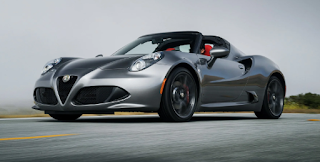 |
| Alfa Romeo’s 4C Spider Is A Lightweight Sports Car Without The Sacrifices |
Luxury amenities and safety enhancements have bloated our once-lightweight, easy-to-handle sports cars. Fifty years ago, for instance, the first Porsche 911 weighed in at 2,300 pounds. Today’s model tips the scales at almost 3,500 pounds. This obesity epidemic—which plagues all vehicles—makes them inefficient, sluggish in turns, and in need of bigger components, such as brakes and engines, which in turn perpetuates the problem.
Alfa Romeo has trimmed the fat without losing any of the luxury or safety that we want in a sports car. At 2,487 pounds, the new 4C Spider is the first modern car with vintage weight. Instead of employing a typical steel frame, its tub-like chassis is made entirely of carbon fiber. The lightweight material allows engineers to use a smaller engine, smaller brakes to rein it in, and lighter components throughout, and its stiffness enhances handling.
The result: a high feedback car that accelerates to 60 mph in a brisk 4.1 seconds and can stop on a dime. That’s supercar-level performance. Yet the 4C does not come with a supercar price tag. Alfa’s greatest breakthrough might be in offering the 4C for $63,900. Cars that use comparable amounts of carbon fiber typically top $200,000. That kind of savings will make anyone feel lighter.
1. Stability
The 4C Spider’s single-piece, carbon-fiber chassis provides structure and stiffness for improved handling. Alfa Romeo engineers hand-lay the carbon fibers to ensure they align, which in turn maximizes strength. The result is a weave that’s three times stronger and seven times lighter than steel, according to the carmaker. Carbon fiber throughout the vehicle—windshield frame, trim panels, side mirrors—is mostly for appearances, but further keeps weight to a minimum
2. Handling
Automobile roof structures contribute to vehicle handling, and therefore must be compensated for when cut out to create a convertible. But the inherent stiffness of the carbon-fiber frame allows engineers to make this conversion without adding extra chassis-stiffening hardware, which typically bloats a car by hundreds of pounds. The 4C Spider is only 22 pounds heavier than the coupe.
3. Power
The turbocharged all-aluminum engine produces 237 hp, with precise fuel injection to make the most of every drop of gas. Variable-valve timing maximizes power at different RPM. The engine’s placement—behind the seats—enhances balance, though it severely limits trunk space. (But this isn’t a car for golf trips anyway.) The engine is mated to a rapid-response dual-clutch transmission that sends power to the wheels without interruption, even during gear shifts. Four drive modes maximize handling in different conditions.